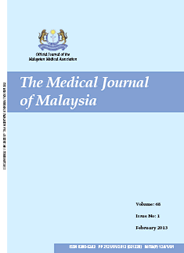MJM, Vol 70 Supplement 1 September 2015
The effects of sociocultural pressure on disordered
eating among adolescents in Malaysia, what public health prevention programmes
can do?
*Department of Social and Preventive Medicine, Faculty of Medicine, University Malaya, Kuala Lumpur, **Julius Centre University of Malaya, Faculty of Medicine, University of Malaya, Kuala Lumpur, ***University of Malaya Centre for Addiction Sciences, Faculty of Medicine, University of Malaya, Kuala Lumpur
ABSTRACT
Background: Disordered eating would be debilitating if it reaches the clinical diagnostic criteria of an eating disorder. Sociocultural pressure portrayed in various forms is known to have a main effect on disordered eating. Perceived pressure to be thin along with weight teasing from family, friends, peers and media depictions have demonstrated disturbed eating habits. The present study aim to assess the prevalence of disordered eating in a school-based population in Selangor and to assess the sociocultural influence.
Methods: In this cross-sectional study, data were collected from 601 students, aged between 13 and 16 years old from national secondary schools in Selangor. Participants completed the EAT-26 (Eating Attitude Test) and the Perceived Sociocultural Pressure Scale (PSPS). Logistic regression analysis was used to determine the effect of PSPS domains on disordered eating among.
Results: The prevalence of disordered eating was 19.8% (95% CI: 16.5-23.5). More females 20.8% (95% CI: 16.6-25.8) and adolescents who were overweight 26.5% (95 % CI: 18.3-36.7) had disordered eating. The common types of disordered eating practices were binge eating, 4.10% (95% CI: 2.70-6.00), and excessive exercising, 6.50% (95% CI: 4.70-9.00). Perceived sociocultural pressure from family and friends (odds ratio (OR) 1.60; 95% CI: 1.16-2.21), media (OR 1.53; 95% CI: 1.20-1.94) and weight teasing (OR 1.39; 95% CI: 1.01-1.90) were found to be associated with disordered eating.
Conclusion: Pressures to be thin exerted through family and social environment have shown to influence the risk in developing disordered eating. Public health professionals along with teachers and parents can play a pivotal role to help adolescents with disordered eating to develop acceptance about their weight, appearance and the importance of social comparison. Policy makers must review the portrayal of thin images and its effect of media on adolescents and the media should advocate more positive and self-esteem building messages among adolescents.
Keywords: Disordered Eating, Sociocultural Pressure, Public Health Prevention Programs
